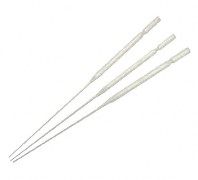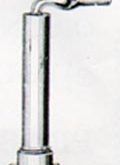
The Pasteur Pipet was a basic instrument that played a crucial role in the experiments of Louis Pasteur experiments. Once the concept of Germ Theory was clearly established, the necessity to keep everything sanitized and free of germs was central to all experiments. Therefore, the Pasteur Pipet was developed to ensure liquids could be removed or transferred without introducing foreign elements that could possibly pollute the contents.
The pipet used during Louis Pasteur’s time was a simple glass tube with cotton wadding stuffed into one end. The cotton allows air to pass into the pipet’s glass tube, but is fine enough to filter microbes from the air to ensure the content will not become contaminated. The opposite end of the pipet was heated until the glass becomes maleable and then extended, creating an elongated tip. The tip is then severed, creating an extremely small opening into which the liquid can enter. This video below demonstrates an older method for manufacturing the Pasteur Pipet.
How to Use a Pasteur Pipet
- With the cotton filled end uncovered, insert the pointed end of the Pasteur Pipet into the liquid, allowing the glass tube to fill.
- Cover the cotton filled end with your thumb, trapping the liquid in the Pasteur Pipet. Covering the end of the Pasteur Pipet ensures there is no way the liquid can be displaced with air.
- Remove the Pasteur Pipet from the container.
- Insert the Pasteur Pipet into the new container in which you wish to transfer the liquid.
- Remove your thumb from the end while lifting the Pasteur Pipet from the container. This allows the liquid to flow out of the Pasteur Pipet.
Old Technique of Manufacturing a Pasteur Pipet
Thanks to tgw1916.net for the video.
 Pasteur Brewing Louis Pasteur – Science, Health, and Brewing
Pasteur Brewing Louis Pasteur – Science, Health, and Brewing 


